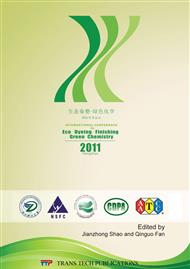[1]
Arcand-Hoy. LD, Nimrod. AC, Benson. WH, Endocrine-modulating substances in the environment estrogenic effects of pharmaceutical products, Int. J. Toxicol. 17 (1998) 139-158.
DOI: 10.1080/109158198226675
Google Scholar
[2]
Kolpin DW, Furlong ET, Meyer MT, Thurman EM, Zaugg SD, et al, Response to comment on Pharmaceuticals, hormones, and other organic wastewater contaminants in US streams, 1999–2000: a national reconnaissance, Environ Sci Technol. 36 (2002).
DOI: 10.1021/es0201350
Google Scholar
[3]
Schröder P, Navarro-Aviñó J, Azaizeh H, Goldhirsh A, DiGregorio S, et al, Using phytoremediation technologies to upgrade waste water treatment in Europe, Environ Sci Pollut Res. 14(2007) 490–497.
DOI: 10.1065/espr2006.12.373
Google Scholar
[4]
Waterston. K, Wang. JWJ, Bejan. D, Bunce. NJ, Electrochemical waste water treatment: Electrooxidation of acetaminophen, J. Appl. Electrochem. 36(2006) 227-232.
DOI: 10.1007/s10800-005-9049-z
Google Scholar
[5]
Vogna. D, Marotta. R, Napolitano. A, d'Ischia. M, Advanced oxidation chemistry of paracetamol. UV/H2O2-induced hydroxylation/degradation pathways and 15N-aided inventory of nitrogenous breakdown products, J. Org. Chem. 67 (2002) 6143-6151.
DOI: 10.1021/jo025604v
Google Scholar
[6]
Skoumal. M, Cabot. PL, Centellas. F, Arias. C, Garrido. JA, Brillas. E, Mineralization of paracetamol by ozonation catalyzed with Fe2+, Cu2+ and UVA light, Appl. Catal. B: Environ. 66 (2006) 228-240.
DOI: 10.1016/j.apcatb.2006.03.016
Google Scholar
[7]
Liming Yang, Liya E. Yu, Madhumita B. Ray, Degradation of paracetamol in aqueous solutions by TiO2 photocatalysis, Water Res. 42 (2008) 3480-3488.
DOI: 10.1016/j.watres.2008.04.023
Google Scholar
[8]
Zein MM, Suidan MT, Venosa AD, MTBE biodegradation in a gravity flow, high-biomass retaining bioreactor, Environ Sci Technol. 38 (2004) 3449-3456.
DOI: 10.1021/es030652y
Google Scholar
[9]
A.M. Maszenan, Yu Liu, Wun Jern Ng, Bioremediation of wastewaters with recalcitrant organic compounds and metals by aerobic granules, Biotechnol. Adv. 29 (2011) 111-123.
DOI: 10.1016/j.biotechadv.2010.09.004
Google Scholar
[10]
Yong-Qiang Liu, Benjamin Moy, Yun-Hua Kong, Joo-Hwa Tay, Formation, physical characteristics and microbial community structure of aerobic granules in a pilot-scale sequencing batch reactor for real wastewater treatment, Enzyme Microb. Technol. 46 (2010).
DOI: 10.1016/j.enzmictec.2010.02.001
Google Scholar
[11]
Sunil S. Adav, Duu-Jong Lee, Juin-Yih Lai, Functional consortium from aerobic granules under high organic loading rates, Bioresour. Technol. 100 (2009) 3465-3470.
DOI: 10.1016/j.biortech.2009.03.015
Google Scholar
[12]
Jiang HL, Tay JH, Liu Y, Tay STL, Bacterial diversity and function of aerobic granules engineered in a sequencing batch reactor for phenol degradation, Appl Environ Microbiol 70 (2004) 6767-6775.
DOI: 10.1128/aem.70.11.6767-6775.2004
Google Scholar
[13]
Tomei MC, Annesini MC, Luberti R, Cento G, Senia A, Kinetic of 4-nitrophenol biodegradation in a sequencing batch reactor, Water Res. 37 (2003) 3803-3814.
DOI: 10.1016/s0043-1354(03)00297-5
Google Scholar
[14]
Zhang LL, Zhang B, Huang YF, Cai WM, Application of aerobic granulation in polishing the UASB effluent, Environ Technol. 26 (2005) 1327-1334.
DOI: 10.1080/09593332608618611
Google Scholar


